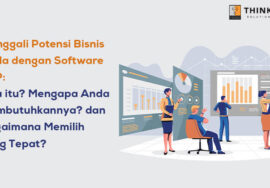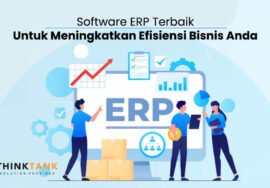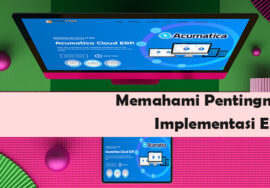What can an ERP system do for HR?
As companies strive to stay competitive in the current business climate, they are increasingly turning to technology to help them manage their operations more efficiently. One of the most important tools for achieving this is an ERP system, which stands for Enterprise Resource Planning. But what can an ERP system do for HR? In this blog post, we’ll explore the features of an ERP system for HR, compare it to an HRMS, and explain the differences between the two. We’ll also discuss the advantages of using an ERP system for HR and how it can help you streamline your HR processes. So, if you’re looking for a way to improve your HR management, read on to find out more.
What is the meaning of ERP?
ERP stands for Enterprise Resource Planning. It’s the name given to software that enables companies to manage different business areas, such as human resources, for example.
ERP stands for Enterprise Resource Planning and is a type of software that provides organizations with comprehensive business management capabilities. ERP systems include modules for people management, such as Human Resources (HR). These solutions provide companies with the ability to streamline operations, increase efficiency, and improve decision-making processes.
ERP systems are designed to integrate different areas of an organization’s operations, including finance, materials management, sales and distribution, customer relationship management (CRM), and human resources. By bringing all these aspects of a business together into one system, it helps ensure that information is shared accurately and consistently across departments. This allows leaders to make informed decisions quickly and effectively without having to manually compile data from multiple sources.
ERP systems provide organizations with the capability to automate the HR process by tracking employee information such as attendance records, payroll processing, performance reviews, benefits administration, recruitment activities, and job postings. It also provides powerful analytics tools that allow administrators to assess workforce trends in real time so they can make decisions based on data-driven insights rather than instinct or guesswork.
In addition to providing visibility into HR processes on an enterprise level, ERP systems also offer scalability for businesses looking to expand their teams or move into new markets. Companies can easily customize their ERP solutions as their needs change over time without having to invest in additional hardware or software solutions. This makes them a cost-effective option for businesses looking for ways to reduce costs while maximizing efficiency and productivity within their organization.
Features of an ERP for HR
Today there are a variety of different digital tools that can make the HR department’s life easier. One of these is the Human Resources Management System (HRMS). This HR software has been specifically designed to manage, computerise and automate the HR department’s processes.
An Enterprise Resource Planning (ERP) system is a powerful tool that can help HR departments streamline their processes and gain access to valuable insights. ERP systems offer a wide range of features and functionalities that can be tailored to the needs of any organization.
The core features of an ERP for HR departments include payroll management, employee tracking, time-tracking, compensation planning, recruitment and onboarding processes, as well as performance management. These features allow organizations to easily manage employee data such as salary information, attendance records, and job descriptions. Furthermore, the ERP system can help HR managers generate reports on key metrics like turnover rates or employee productivity levels.
In addition to these core functions, there are also additional tools available in an ERP system that can further improve the effectiveness of the HR department. For instance, some ERPs offer automated email notifications for new hires or contract renewals. This feature helps ensure compliance with relevant regulations while keeping employees informed about important changes in their roles and responsibilities. Some systems also provide comprehensive training modules for new staff members which makes it easier to onboard them into the organization quickly and efficiently.
Finally, an ERP system is equipped with analytics tools that allow HR teams to generate detailed reports on various aspects of their workforce such as turnover rates or skill gaps between existing employees. This information can then be used to make informed decisions about resource allocation or hiring practices based on real-time data analysis.
Overall, an ERP system provides a comprehensive platform for managing all aspects of HR operations within an organization while also allowing for efficient communication between departments and improved decision making capabilities based on available data insights.
Features of an ERP HR module
As we mentioned previously, an ERP consists of a range of modules that serve different business areas. The human resources part usually helps automate the tasks that take up most of this department’s time.
An ERP HR module is designed to automate many of the manual processes typically associated with managing a company’s human resources. It allows managers and HR professionals to quickly access employee data, track attendance and absences, create detailed reports on performance metrics, and manage payroll efficiently.
The HR module includes features such as: automated time tracking; comprehensive recruiting and onboarding tools; compensation planning capabilities; email notifications for employees; customizable training modules; and powerful analytics tools for generating reports. All of this helps organizations save time, money, and resources while also providing better insights into their workforce.
The automated time tracking feature of an ERP system makes it easy to keep track of employee hours worked. Managers can use this feature to monitor attendance patterns and ensure that employees are not taking advantage of their work schedule. Additionally, the system can be configured to send out reminders when an employee is approaching overtime or has exceeded their allotted hours for the week.
Compensation planning is another key part of an ERP HR module. This feature enables managers to set up salary structures based on job roles within the organization as well as industry standards and competitive salary trends in order to attract top talent. The software can also be used to generate reports on different pay grades so that employers can make informed decisions about how best to reward employees for their contributions.
Finally, the analytics tools available in an ERP HR module allow organizations to gain valuable insights into their workforce performance metrics such as turnover rates, number of sick days taken per year, average productivity levels across departments or teams etcetera. These insights help inform decision making regarding recruitment strategies, performance reviews or career development plans – ultimately leading to a better engaged workforce overall.
In conclusion, an ERP system offers numerous benefits for managing human resources in any organization – from automating mundane tasks like time tracking or payroll processing processes all the way up through analytics-driven decision making around compensation planning or recruitment strategies. It provides a comprehensive platform that enables companies to effectively manage their workforce while also gaining valuable insights into employee performance metrics at the same time – ensuring that they stay ahead of the competition in terms of efficiency and effectiveness when it comes down to managing people-related matters within the business environment.
Features of an HRMS
An HRMS (Human Resource Management System) is a cloud-based software solution designed to manage and streamline people management processes within an organization. It provides a suite of features that make it easier for HR departments to track, manage, and analyze employee data. From recruitment tracking to performance appraisals, an HRMS allows organizations to automate mundane tasks, improve collaboration with employees, and generate insights into their workforce.
For starters, an HRMS offers powerful recruitment tools that enable organizations to track job applications and quickly identify suitable candidates. It also provides automated onboarding capabilities so new hires can be brought up to speed quickly. With its intuitive user interface, the system makes it easy for administrators to configure settings for different types of users and customize access permissions accordingly.
Rather than relying on manual processes such as paper-based time cards or spreadsheet tracking sheets, an HRMS automatically tracks employee attendance through digital clock-in systems. It helps organizations save time by simplifying payroll processing while also providing analytics-driven insights into employee productivity levels or turnover rates. Additionally, it offers comprehensive compensation planning capabilities so managers can easily adjust salaries based on market trends or merit increases.
Finally, an HRMS provides extensive training modules so employees can stay up-to-date with the latest industry developments or hone their skills in specific areas such as customer service or teamwork. These modules are customizable according to the organization’s needs and offer convenient online learning options for employees who wish to take courses remotely or at their own pace.
Difference between ERP and HRMS
As we can see, there are significant differences between an ERP and an HRMS. The main difference is that an ERP is designed from a business management perspective, and an HRMS serves the specific needs of a human resources department.
A quality HRMS covers most of the day-to-day processes in people management. These systems have been created to save you time, improve the efficiency and the strategic influence of the department within the company. And for this reason, they include features that you won’t find in an ERP.
An ERP system offers a solid foundation for managing business operations, but an HRMS is tailored specifically to the unique needs of human resources departments. For instance, an ERP does not typically have powerful recruitment tools such as applicant tracking and job board integrations. An HRMS also has specialized features for employee engagement and performance management, including feedback systems, goal setting modules, and automated recognition awards. These features are designed to boost morale while also improving productivity and reducing turnover rates.
Another key difference between the two systems is in terms of scalability. An ERP can easily be scaled up or down depending on the size of the organization, whereas an HRMS is often more limited in terms of customization options and may require additional investments to scale up or down as needed. Additionally, HRMS solutions are generally better suited for smaller organizations due to their lower cost structure compared to enterprise-level ERP systems.
In conclusion, it is clear that both an ERP system and an HRMS offer valuable benefits for businesses looking to streamline their human resources processes. While an ERP provides a comprehensive platform for managing business operations, an HRMS provides specialized features designed specifically for people management. Ultimately, it is important to consider each system’s unique strengths and weaknesses when deciding which one will best suit your organization’s needs.








Pingback: ERP System Scalability for SMEs with ERPNext | OptiSys
Pingback: Navigating Business Operations Like an Octopus | OptiSys